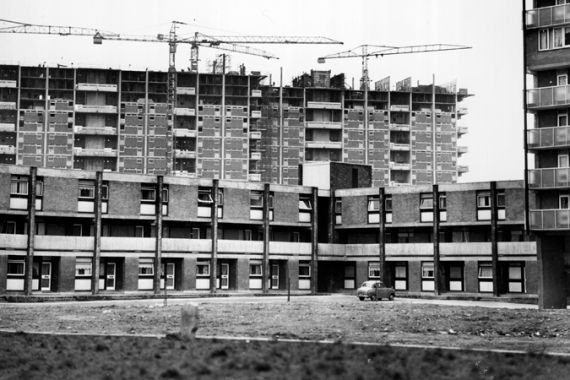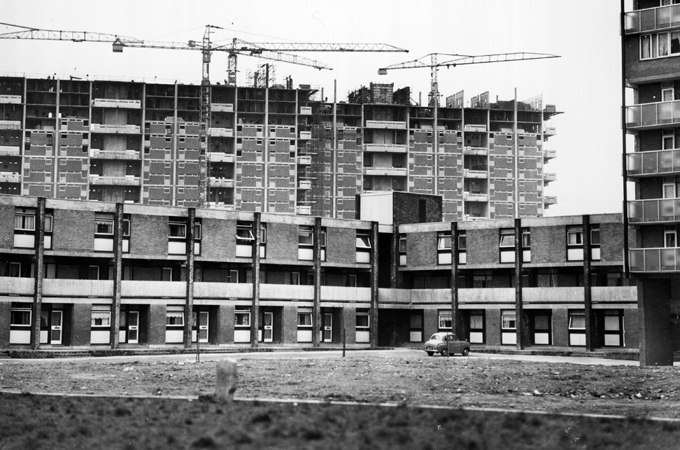Breaking up the gangs of Glasgow from within
Gang violence in Glasgow appeared insoluble, until police came across a new approach that seems, so far, to work.

 |
| Glasgow was once dubbed the ‘Scottish Chicago’ for its high rates of violent crime [GALLO/GETTY] |
Glasgow witnessed a remarkable scene on October 24, 2008, when some 120 gang members were escorted into court by police wearing full riot gear. The young men were herded through a cordon of mounted police standing at the entrance, while in the sky above, a police helicopter hovered noisily. Once the gangs were inside and seated, the chief of police stood up and delivered a tough message while pictures of the thugs were simultaneously flashed up on large screens brought in for the unprecedented meeting.
The youths were visibly shocked, and after the police had delivered its ultimatum, ordinary people stood up and spoke about how gang violence in Scotland’s largest city had blighted their lives. Speakers included an Accident and Emergency consultant who explained the problems of dealing with knife victims who had had their faces slashed open. He was followed by a mother who told how her 13-year-old son was set upon by a gang and attacked with machetes. The injuries he sustained to his face were so severe that he was unrecognisable when she visited him in hospital.
The above scenario was not a court case, but what is referred to in Scotland as a “call-in”, an initiative fundamental to a resoundingly successful project that is fighting gang culture in a place notorious for street violence. There are some 170 gangs in Glasgow, with an estimated 3,500 members. On a per capita basis, this is six times as many teenage gangs as there are in London, which has ten times the population. With monikers such as Young Parkhead Rebels, The Drummy, and Auchinearn Young Team, which reflect the city’s different areas, gang culture is ingrained into the mindset of the city’s youth.
Indeed, there is a history of street violence in Glasgow tracing back to the 19th century, when the city saw the rise of the Penny Mobs. By the 1930s, Glasgow had acquired such an unenviable reputation throughout Britain for mass street brawls that it was dubbed the “Scottish Chicago”, its infamous razor gangs responsible for the horrendous facial scarring known as the “Glasgow smile”.
By the mid-noughties, such was the extent of the violence that, according to the UN, Scotland had the sixth fastest-rising murder rate anywhere in the world. Most of the 109 homicides recorded in 2006 took place in the west of Scotland, with Glasgow emerging as the most violent city in Western Europe with a murder rate of five deaths per 100,000, up from 4.49 the previous year.
|
Doctors in Glasgow deal with around 300 attempted murders a year and a serious facial injury every six hours |
The official figures do not do justice to the extent of the violence, according to Strathclyde Police – who point out that doctors in Accident and Emergency departments across the area deal with around 300 attempted murders a year and a serious facial injury every six hours. Most of the assaults are gang-related, with alcohol and drugs major factors. Much of the violence takes place at the weekends in bleak housing projects and city parks, or even sometimes in the city centre, where groups of marauding teenagers – girls and boys – battle each other with knives, machetes, swords and iron bars.
When Karyn McCluskey took a job as an intelligence analyst with Strathclyde Police in 2002, she was appalled at the murder statistics in Glasgow. She came from West Mercia Constabulary, which covered a largely rural area in England. After venturing north of the border, the scales fell from her eyes. “What was unnerving about the violence was that it was recreational. These youths were fighting because they wanted to. We’re talking about teenagers who know nothing but violence from what they’ve experienced at home and in their communities. We are talking about extremely violent people,” says McCluskey, who is deputy head of Strathclyde Police’s Violence Reduction Unit.
Over time, the Scottish authorities had tried various measures to control the chaos but most initiatives only worked in the short term, if at all. Tougher sentences were introduced, but these only created vacuums for younger gang members to step into. Furthermore, many convicted offenders returned from prison emboldened by their time inside. McCluskey had read about a community-based policing project in the US called Ceasefire, which had been successful in reducing violence in Boston housing projects experiencing crack epidemics in the 1980s and 90s. At that time, gang-related homicides soared by 230 per cent, despite harsher sentencing.
New methods of reducing the violence
Research into the Boston problem in 1996 by an academic named David Kennedy found that the city had 61 drug gangs with 1,300 members. He advised embarking upon a new approach by summoning gang members to forums, or “call-ins”. McCluskey explains:
|
“During call-ins, gang members were treated like adults. They were told what they were doing was causing massive damage to their families and communities and that the violence must stop. The police said that any further violence would result in the whole group being punished. Relatives of victims and ex-offenders also attended, as did social workers who offered gang members a way out through help seeking housing and jobs. Gang ‘loyalty’ was also challenged, and members were made to think about questions such as, ‘Will your friends visit you in prison? How long will it take your friends to sleep with your girlfriend when you’re in jail?’ The psychology was to dismantle the rules of the street.” |
The strategy was an astounding success. Before Ceasefire, Boston was averaging around 100 homicides a year, but by 1999 it was down to 31. Although there were few guns on the streets of Glasgow, McCluskey believed the approach could work in Scotland, so she invited Kennedy to Glasgow where he convinced her sceptical colleagues. A £5m ($7.86m) package was raised, and McCluskey was able to set up a multi-agency pilot project in the east end of the city called the Community Initiative to Reduce Violence (CIRV), which brought together people from justice departments, government, housing, education, social work, health and the community.
“After 18 months of planning, we were ready for the first call-in at Glasgow Sheriff Court in 2008. It was powerful stuff and some of the young men were crying because, despite the bravado, they all love their mums. That was the most powerful thing in the US and it was the most powerful aspect here too,” McCluskey explains.
Other speakers included social and youth workers, who offered the gang members an escape route and help to get jobs and housing. Former gang members also spoke, including Gary Connor, who for years had been responsible for some of the mayhem in Glasgow. “I was always in trouble, running with older boys. By the age of 12, I was carrying a knife. By the age of 15 I’d been sentenced to two years in a secure unit. But that only added to my notoriety on the street. I was stabbed three times but thought I was invincible,” he says.
Connor has four pages of convictions for vandalism, assault, and offences such as breach of the peace, but his longest stretch in prison was for a fight that led to the death of someone he knew.
“He was a friend and we got in a fight and he battered me. I couldn’t let it go so we fought again and he fell under a bus. I did my time in Barlinnie, Shotts and Kilmarnock prisons. I spent most of my time inside fighting. When I came out, I was back with the gang and I started selling drugs. But then my past started catching up with me. I was attacked by someone with a bottle and the brother of the guy I killed attacked me with a machete. The violence was never-ending,” Connor says.
Connor was in court the day of Scotland’s first call-in and recalls a mother speaking about her love for a son who had been murdered in a gang fight. As he listened, he felt an overwhelming sense of shame, guilt and remorse. “I knew that I’d caused the same pain for someone else’s ma because I’d killed a man in a fight,” the 33-year-old Glaswegian says.
When Connor heard the woman talk about her loss, it was his first time in a courtroom since being convicted of culpable homicide a few years earlier. For that he was sentenced to four years in prison. His crime was the street brawl that led to his friend being killed when he fell under the wheels of a passing bus. It was a moment that will haunt him for the rest of his life. “When she (the mother) explained the way she felt about losing her child, all I could think about was that I’d taken someone’s life. That I’d taken someone’s life. I can’t explain the way that makes me feel,” he says.
Former gang members talk
There was complete silence in court when that woman shared her grief. Then it was Connor’s turn to stand and address the packed courtroom. He spoke candidly about the drug- and alcohol-fuelled violence he once inflicted on others and his experiences in jail. He was speaking in his role as a volunteer with CIRV, attending call-ins and trying to convince young men to eschew gangs. “I was battered by my father when I was child so I grew up with violence. CIRV helped me get a new life. I moved away from the area I grew up in, and the gang. I don’t drink, smoke or take drugs anymore and I can even sit and talk to the police. I’m also the father of a seven-year-old girl and I want to put something back and convince others to avoid the road I took.”
To date, there have been ten “call-ins” in Glasgow, which have been attended by 473 youths. The latest figures show a nearly 50 per cent drop in youth crime. McCluskey says:
|
“Violent offending by those who have signed up to CIRV has reduced by 46 per cent, rising to 73 per cent amongst those who undertook CIRV’s most intensive programmes. These figures are testimony to the great work done by everyone involved with CIRV and to the commitment of young men who genuinely want to change their behaviour. But gang violence hasn’t stopped. It’s been a problem for Glasgow for years and it won’t go away overnight. We’ve made inroads into tackling it, but the key now is keeping up momentum. If we can look back in ten, 20 years and still see a reduction, then we’ll know this has worked.” |
CIRV will now become part of everyday business for Strathclyde Police, with plans to expand the project to the south of the city and, in the wake of recent riots in the UK, other British police forces are watching with interest.
Billy Briggs is an award-winning freelance journalist. His work has appeared in the New Statesman, The Guardian, the Sunday Times and other publications around the world.
The views expressed in this article are the author’s own and do not necessarily represent Al Jazeera’s editorial policy.
